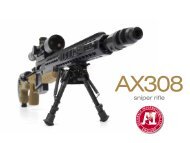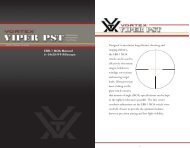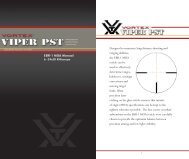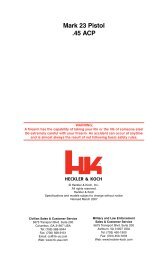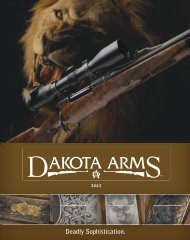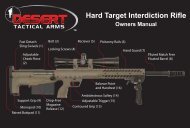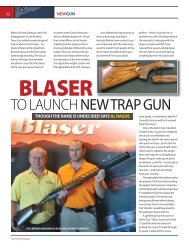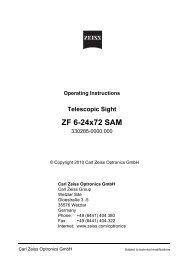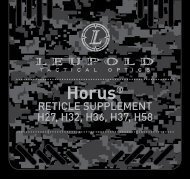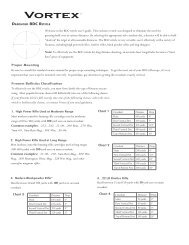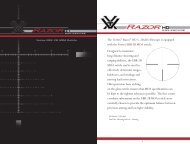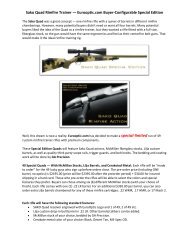BRH(I) / BRX - Euro Optics Ltd.
BRH(I) / BRX - Euro Optics Ltd.
BRH(I) / BRX - Euro Optics Ltd.
Create successful ePaper yourself
Turn your PDF publications into a flip-book with our unique Google optimized e-Paper software.
<strong>BRH</strong>(I) / <strong>BRX</strong><br />
RETICLE
General Information:<br />
MIL 5.5 18 36 55 73 91 109 127 145 164 182<br />
Congratulations on your purchase of a<br />
SWAROVSKI OPTIK Rifle Scope with the<br />
<strong>BRH</strong>(I)/<strong>BRX</strong> Reticle System. These reticles<br />
were designed primarily for long range<br />
shooting and to take the guesswork out of<br />
how high to hold over a game animal or target<br />
by utilizing the marker bars or dots below the<br />
main horizontal crosshair. The <strong>BRH</strong>(I)/<strong>BRX</strong><br />
Reticle will also compensate for wind drift by<br />
use of the wind posts or ends of the marker<br />
bars for aiming. These features eliminate the<br />
need for making turret adjustments to your<br />
rifle scope.<br />
The <strong>BRH</strong>(I)/<strong>BRX</strong> Reticles have exactly the<br />
same distances between the bars and dots.<br />
They are essentially the same except for<br />
reticle thickness.<br />
<strong>BRX</strong> Reticle: Fine dimensions designed for<br />
Target/Varmint shooting.<br />
<strong>BRH</strong>(I) Reticle: Standard dimensions offering<br />
better low light visibility for big game hunting.<br />
The chief benefit of the <strong>BRH</strong>(I)/<strong>BRX</strong> Reticle is<br />
the simplicity of the system and ease of use. A<br />
good quality range finder is the fastest method<br />
to determine the distance to the target for the<br />
most accurate results with the <strong>BRH</strong>(I)/<strong>BRX</strong><br />
Reticle. You may also determine range with<br />
the reticle explained later in this manual (see<br />
page 9).<br />
The <strong>BRH</strong>(I)/<strong>BRX</strong> system is supported by 50<br />
factory ballistic decals, a selection chart with<br />
approximately 500 factory loads that can be<br />
used in conjunction with these decals, and 5<br />
blank decals that can be customized to your<br />
factory load, reload, or preferred zero distance<br />
by using the <strong>BRH</strong>(I)/<strong>BRX</strong> Ballistic Calculator<br />
on our website at WWW.SWAROVSKIOPTIK.COM.<br />
1
Heavy Post<br />
Marker Bar 1<br />
Marker Bar 2<br />
Marker Bar 3<br />
Marker Bar 4<br />
Marker Bar 5<br />
Wind Post<br />
The <strong>BRH</strong>(I)/<strong>BRX</strong> is Simple to Use:<br />
You’re on an antelope<br />
hunt. You are using a<br />
rifle in 7 mm Remington<br />
Magnum.<br />
1.Your range finder shows<br />
the pronghorn is 447 yds<br />
away.<br />
2. Look at your decal for<br />
the load you are using.<br />
3. Look through the scope<br />
and hold the 2 nd marker<br />
bar down where you want<br />
the bullet to hit, and fire.<br />
Set up is simple and easy. Find your factory<br />
load from the Ballistic Decal Selection Chart<br />
with this manual, match your load to the<br />
appropriate decal number and sight in at 200<br />
yards. Grab your range finder and you’re ready<br />
for any reasonable long distance shot.<br />
Sighting in Distance:<br />
Main Central<br />
Crosshair<br />
Dot 1<br />
Dot 2<br />
Dot 3<br />
Dot 4<br />
380<br />
520<br />
640<br />
750<br />
The zero or sighting in distance for the <strong>BRH</strong>(I)/<br />
<strong>BRX</strong> system is based on a 200 yard zero on the<br />
main central crosshair. This zeroing distance<br />
has always been favorable for long range hunting<br />
MIL 5.5 45 61 76 91 106 121 136 152 167 182<br />
2
cartridges. In most instances, you will only be<br />
between 1 and 2 inches high at 100 yards<br />
with a 200 yard zero. If you wish to zero<br />
your reticle at 100, 250, 300 yards/meters<br />
or any other distance, there is no reason you<br />
can’t. Simply access the <strong>BRH</strong>(I)/<strong>BRX</strong> Ballistic<br />
Calculator at WWW.SWAROVSKIOPTIK.COM. Enter<br />
in the appropriate ballistic information (ballistic<br />
coefficient and velocity being the most<br />
important), desired zero setting and enter the<br />
resulting downrange values of the marker bars<br />
and dots on the blank decals provided.<br />
Decal Choice and Usage<br />
Every cartridge has its own unique trajectory.<br />
Some trajectories are virtually identical among<br />
the thousands of cartridges in existence.<br />
SWAROVSKI OPTIK has taken hundreds of<br />
these virtually identical trajectories and matched<br />
them to Factory Ballistic decals that are<br />
supplied with every <strong>BRH</strong>(I)/<strong>BRX</strong> Reticle scope.<br />
Any one decal can be thought of as a template<br />
trajectory for the many other cartridges listed<br />
in the accompanying Ballistic Decal Selection<br />
Chart. The cartridge listed at the top of one of<br />
the 50 decals is an example for that specific<br />
cartridge listed of the downrange values listed<br />
on the decal, but this trajectory may be virtually<br />
identical to many other cartridges.<br />
Your chosen factory cartridge may already be<br />
one of decals provided and you may simply<br />
use that one. If your cartridge is not one of<br />
the factory supplied decals, refer to the Decal<br />
Selection Chart on the inside cover of this<br />
manual. Once you have found your cartridge,<br />
look across the row to the far right to see<br />
the decal number that corresponds with the<br />
trajectory of your chosen cartridge. Keep in<br />
mind that in many instances the appropriate<br />
decal number will be of a different cartridge<br />
or caliber.<br />
3
For example, say the cartridge you are using<br />
is a 300 Winchester Magnum manufactured<br />
by Federal with a 165 gr Nosler Partition<br />
bullet with a muzzle velocity of 3050 feet per<br />
second. This is how that cartridge is listed in<br />
the Ballistic Decal Selection Chart:<br />
Cartridge: 300 Winchester Magnum<br />
Brand: Federal<br />
Bullet Weight & Type Velocity: 165 gr Nosler Partition<br />
3050 fps<br />
B.C.: 0.409<br />
Decal No.: use #42, 325 WSM<br />
Locate decal number 42 (see below) for a 200<br />
gr 325 WSM cartridge:<br />
This 200 gr 325 WSM<br />
decal is the decal you<br />
will use for your 165 gr<br />
300 Win Mag load as it<br />
has virtually the identical<br />
trajectory. Write in 300<br />
Win Mag 165 gr next to the<br />
letters “Alt” on the decal.<br />
(Alt = alternate cartridge<br />
with same ballistic path).<br />
The decal is designed to<br />
be applied to your rifle in a<br />
convenient location where<br />
it can be referred to easily.<br />
Recommendation:<br />
It is strongly recommended that you use a<br />
“sharpie” or marker to now block out the<br />
caliber designation on your appropriate decal<br />
if it is a different caliber than the rifle you are<br />
using. Although it is just common sense, this<br />
small effort may prevent someone from trying to<br />
chamber the wrong cartridge in your rifle. The<br />
manufacturer line, the bullet weight line and<br />
the velocity line should also be blocked out.<br />
350<br />
480<br />
580<br />
680<br />
BR<br />
Th<br />
dot<br />
foll<br />
Eng<br />
Inch<br />
@ m<br />
Bar<br />
Dot<br />
Bar<br />
Dot<br />
Bar<br />
Dot<br />
Bar<br />
Dot<br />
Bar<br />
Len<br />
Ma<br />
Bar<br />
from<br />
from<br />
Bar<br />
from<br />
from<br />
Bar<br />
from<br />
from<br />
Bar<br />
from<br />
from<br />
Bar<br />
from<br />
from<br />
4
e<br />
nt<br />
e<br />
xt<br />
g<br />
e.<br />
r/<br />
d/<br />
ot<br />
te<br />
ot<br />
e.<br />
u<br />
st<br />
a<br />
s,<br />
d,<br />
t.<br />
at<br />
rd<br />
to<br />
of<br />
to<br />
e<br />
g<br />
s<br />
s.<br />
s<br />
ft<br />
to<br />
e<br />
m<br />
d<br />
To demonstrate how the <strong>BRH</strong>(I)/<strong>BRX</strong> system<br />
works combining similar trajectories, the<br />
following is an example of the cartridge’s<br />
(165 gr 300 Win Mag & 200 gr 325 WSM)<br />
exact downrange “Marker Bar & Dot” values,<br />
calculated in a standard atmosphere*, and<br />
how they are rounded for the decal:<br />
165 gr 300 Win Mag<br />
Zero - 200 yds<br />
Bar 1 - 282 yds<br />
Dot 1 - 354 yds<br />
Bar 2 - 419 yds<br />
Dot 2 - 478 yds<br />
Bar 3 - 533 yds<br />
Dot 3 - 583 yds<br />
Bar 4 - 631 yds<br />
Dot 4 - 676 yds<br />
Bar 5 - 717 yds<br />
200 gr 325 WSM<br />
Zero - 200 yds<br />
Bar 1 - 282 yds<br />
Dot 1 - 351 yds<br />
Bar 2 - 415 yds<br />
Dot 2 - 475 yds<br />
Bar 3 - 530 yds<br />
Dot 3 - 583 yds<br />
Bar 4 - 632 yds<br />
Dot 4 - 680 yds<br />
Bar 5 - 724 yds<br />
Rounded value for<br />
325 WSM decal<br />
Zero - 200 yds<br />
Bar 1 - 280 yds<br />
Dot 1 - 350 yds<br />
Bar 2 - 420 yds<br />
Dot 2 - 480 yds<br />
Bar 3 - 530 yds<br />
Dot 3 - 580 yds<br />
Bar 4 - 630 yds<br />
Dot 4 - 680 yds<br />
Bar 5 - 720 yds<br />
* A Standard Atmosphere for these ballistic calculations is:<br />
0 feet / meters altitude or Sea Level<br />
59 degrees F or 15 degrees C<br />
78% Relative Humidity<br />
29.92 inches of mercury / Barometric Pressure<br />
Changes in the atmospheric condition can<br />
change trajectories, most notably very high<br />
altitudes. Other factors that can change the<br />
ballistic data are changes in velocity due to<br />
barrel length or slight variations in actual bore<br />
diameter.<br />
You will be able to adjust for different<br />
atmospheric conditions or muzzle velocities<br />
by using the <strong>BRH</strong>(I)/<strong>BRX</strong> Ballistic Calculator<br />
on the SWAROVSKI OPTIK website at<br />
WWW.SWAROVSKIOPTIK.COM.<br />
16<br />
5
Rifle Scope Magnification and its Effect on<br />
Downrange Point of Impact Values:<br />
Please be aware that the downrange values of<br />
the marker bars and dots are at the rifle scope’s<br />
maximum power. If the scope is on a lower<br />
power than maximum, the bars and dots will<br />
indicate distances further away than what the<br />
decal indicates, resulting in a shot that will go<br />
over the intended impact point.<br />
This happens because the reticle is in the 2 nd<br />
focal plane. The distances between the bars and<br />
dots of the <strong>BRH</strong>(I)/<strong>BRX</strong> Reticle are calculated<br />
at the scopes maximum magnification, in<br />
inches at 100 yards and in centimeters<br />
at 100 meters. A change in magnification<br />
will change the effective dimensions of the<br />
distance between the bars and dots. When the<br />
magnification is lowered, everything in the field<br />
of view is getting smaller in size, but the bars<br />
and dots below the main crosshair are staying<br />
the same size. Lowering the magnification has<br />
the effect of increasing the distances between<br />
the marker bars and dots.<br />
This does not indicate the scope must be<br />
on maximum magnification at all times<br />
while hunting. The main central crosshair<br />
value where you have zeroed your scope,<br />
200 yards for example, will never change<br />
(over a horizontal plane) regardless of the<br />
magnification because it is in the exact center<br />
of the optical axis. In most instances, if you<br />
have a shot out to 250 yards, the scope can<br />
be on any magnification while using the main<br />
central crosshair for aiming. If you have a<br />
long shot where you need one of the Marker<br />
Bars or Dots, remember to place the scope on<br />
its maximum magnification.<br />
Sp<br />
(7<br />
as<br />
Ba<br />
pla<br />
itse<br />
You<br />
35<br />
Ma<br />
do<br />
ap<br />
thi<br />
wit<br />
gam<br />
There are many more cartridges in existence<br />
than are included in the Ballistic Decal Selection<br />
6
n<br />
g<br />
rd<br />
6<br />
00<br />
00<br />
7<br />
0<br />
0<br />
3<br />
6<br />
0<br />
2<br />
0<br />
2<br />
0<br />
00<br />
00<br />
7<br />
0<br />
0<br />
3<br />
6<br />
0<br />
2<br />
0<br />
2<br />
d<br />
a<br />
m<br />
L<br />
ur<br />
er<br />
s<br />
e<br />
e<br />
of<br />
lly<br />
e<br />
e,<br />
a<br />
n<br />
e.<br />
14<br />
Chart included with this instruction manual.<br />
If your cartridge is not one of them, ballistic<br />
information can be obtained from ammunition<br />
or bullet manufacturers web sites or catalogs.<br />
This information can then be entered into the<br />
SWAROVSKI OPTIK Ballistic Calculator on our<br />
website at WWW.SWAROVSKIOPTIK.COM.<br />
How to use the <strong>BRH</strong>(I)/<strong>BRX</strong> Marker Bars /<br />
Wind Posts to Compensate for Wind<br />
The Marker Bar lengths and Wind Posts of this<br />
reticle are designed to compensate for wind<br />
drift of any given cartridge. The two leading<br />
factors that affect downrange wind drift are<br />
the Ballistic Coefficient (B.C.) of the bullet<br />
and Wind Speed. The ballistic coefficient<br />
of a bullet is a number assigned to it by the<br />
manufacturer, based on the bullet’s shape,<br />
that helps determine how well the bullet will<br />
travel through air and resist wind. For most<br />
commonly used hunting bullets, ballistic<br />
coefficients range from approximately 0.200<br />
through 0.600. Generally, the higher the<br />
number, the better the bullet’s ability to resist<br />
wind drift. You will find ballistic coefficient<br />
values for cartridges listed in the Ballistic<br />
Decal Selection Chart.<br />
The following illustrations are a general guide<br />
using the Marker Bar lengths and Wind Posts<br />
of the <strong>BRH</strong>(I)/<strong>BRX</strong> Reticle:<br />
If the wind is blowing from left to right, use<br />
the marker bars / wind posts to the right of the<br />
vertical post to compensate.<br />
If the wind is blowing from right to left, use<br />
the marker bars / wind posts to the left of the<br />
vertical post to compensate.<br />
An easy way to remember is to hold the reticle<br />
into the direction the wind is coming from.<br />
7
For bullets with an approximate B.C.* value of 0.500<br />
(wind blowing from left to right)<br />
From the central vertical post to the end of the<br />
marker bar, will compensate for a 20 mph (32<br />
kmh) 90 degree crosswind. The wind post in<br />
the middle of the marker bar will compensate<br />
for a 10 mph (16 kmh) 90 degree crosswind.<br />
Vertical<br />
Crosshair<br />
Wind<br />
Post<br />
Wind Direction<br />
For bullets with an approximate B.C.* value of 0.250<br />
(wind blowing from left to right)<br />
From the central vertical post to the end of the<br />
marker bar, will compensate for a 10 mph (16<br />
kmh) 90 degree crosswind. The wind post in<br />
the middle of the marker bar will compensate<br />
for a 5 mph (8 kmh) 90 degree crosswind.<br />
Vertical<br />
Crosshair<br />
10 mph 20 mph<br />
Wind<br />
Post<br />
Wind Direction<br />
Right end<br />
of Marker<br />
Bar<br />
5 mph 10 mph<br />
Right end<br />
of Marker<br />
Bar<br />
* Many B.C. Values can be found in the “<strong>BRH</strong>(I)/<strong>BRX</strong> Decal Selection<br />
Chart” sheet insert with this manual<br />
8<br />
Ste<br />
at<br />
ap<br />
(Ta<br />
25<br />
If y<br />
E-T<br />
the<br />
[M<br />
0.2<br />
23<br />
(46<br />
Ex<br />
Dif<br />
If<br />
Fe<br />
15<br />
(D<br />
ca<br />
de<br />
de<br />
is 5<br />
ret<br />
do<br />
Ca<br />
qu<br />
us<br />
a<br />
sh<br />
pre<br />
ref<br />
0.2<br />
0.5<br />
0.7<br />
1.0<br />
1.2<br />
1.5
if<br />
ip<br />
a<br />
ot<br />
re<br />
at<br />
at<br />
d<br />
t<br />
Ranging with the <strong>BRH</strong>(I)/<strong>BRX</strong>:<br />
A good quality rangefinder such as the<br />
SWAROVSKI OPTIK LG 8x30 is recommended<br />
for measuring targets at unknown distances<br />
for use with the <strong>BRH</strong>(I)/<strong>BRX</strong> Reticle. If a<br />
rangefinder is not available, the reticle can be<br />
used for estimating distance to the target.<br />
The distance between the bars and dots of<br />
the <strong>BRH</strong>(I)/<strong>BRX</strong> Reticle is calibrated in a<br />
measurement called Mils so that the reticle<br />
can be used for ranging. “Mil” is short for the<br />
word Milliradian, a unit of measurement. A<br />
Milliradian (or Mil) is usually described as 1<br />
yard (36 inches) at 1000 yards, or 1 meter<br />
(100 centimeters) at 1000 meters. At 100<br />
yards, or 100 meters, 1/10 th the distance, 1<br />
Mil = 3.6 inches @ 100 yards or 10 cm @ 100<br />
meters. It is a linear measurement that gets<br />
increasingly wider as the distance increases,<br />
or closer together as the distance decreases.<br />
Each increment of a bar or dot, from the main<br />
horizontal crosshair downward, represents<br />
a distance in 0.5 Mil increments at the rifle<br />
scopes maximum power. The distance<br />
between the 5 th Bar and the top of the lower<br />
vertical heavy post is 1 Mil giving a total of<br />
5.5 Mils to work with for ranging purposes<br />
(see chart below). Note: Because the <strong>BRH</strong>(I)/<br />
<strong>BRX</strong> Reticle is in the 2 nd focal plane, the<br />
magnification must be on the highest power<br />
in order to properly estimate range with the<br />
reticle.<br />
2<br />
9
<strong>BRH</strong>(I)/<strong>BRX</strong> Increment Subtensions:<br />
Bar 1<br />
Dot 1<br />
Bar 2<br />
Dot 2<br />
Bar 3<br />
Dot 3<br />
Bar 4<br />
Dot 4<br />
Bar 5<br />
Top of Lower<br />
Vertical Post<br />
English<br />
in. low at 100 yds<br />
@ max power<br />
1.8 in<br />
3.6 in<br />
5.4 in<br />
7.2 in<br />
9.0 in<br />
10.8 in<br />
12.6 in<br />
14.4 in<br />
16.2 in<br />
19.8 in<br />
Metric<br />
cm. low at 100 m<br />
@ max power<br />
5 cm<br />
10 cm<br />
15 cm<br />
20 cm<br />
25 cm<br />
30 cm<br />
35 cm<br />
40 cm<br />
45 cm<br />
55 cm<br />
1 Mil<br />
2 Mils<br />
3 Mils<br />
Mils<br />
.5 Mil<br />
1 Mil<br />
1.5 Mils<br />
2 Mils<br />
2.5 Mils<br />
3 Mils<br />
3.5 Mils<br />
4 Mils<br />
4.5 Mils<br />
5.5 Mils<br />
0.5 Mil<br />
1.5 Mils<br />
2.5 Mils<br />
On<br />
to<br />
is<br />
Th<br />
(H<br />
the<br />
or<br />
(H<br />
the<br />
Ex<br />
Kn<br />
inc<br />
ho<br />
sh<br />
tom<br />
Ba<br />
0.5<br />
33<br />
Me<br />
0.4<br />
(m<br />
30<br />
4 Mils<br />
3.5 Mils<br />
4.5 Mils<br />
5.5 Mils<br />
10
One measurement you must know beforehand<br />
to accurately range with a Mil system Reticle<br />
is the size of the target you are shooting at.<br />
The formula for using is as follows:<br />
s<br />
s<br />
s<br />
s<br />
s<br />
s<br />
ils<br />
(Height of the target in Yards x 1000) ÷ Height of<br />
the target in Mils = Range to the target in Yards<br />
or<br />
(Height of the target in Meters x 1000) ÷ Height of<br />
the target in Mils = Range to the target in Meters<br />
Example: Your target is a whitetail deer.<br />
Known (average) chest depth is 18 inches. 18<br />
inches is ½ yard or 0.5 yards. You put the<br />
horizontal crosshair on top of the deer at the<br />
shoulder. Looking down the reticle, the bottom<br />
of his 18 inch chest lines up with the 2 nd<br />
Bar of the <strong>BRH</strong>(I)/<strong>BRX</strong> Reticle, or 1.5 Mils.<br />
0.5 yards x 1000 = 500. 500 ÷ 1.5 (mils) =<br />
333 yards.<br />
Metric – 18 inches = 0.5 yd = .4572 m<br />
0.4572 meters x 1000 = 457.2 457.2 ÷ 1.5<br />
(mils) = 304.8 (305 meters)<br />
305 meters = 333 yards<br />
ils<br />
ils<br />
0.5 Mil<br />
1 Mil<br />
1.5 Mils<br />
2 Mils<br />
2.5 Mils<br />
10<br />
11
After determining 333 yards with the reticle, if<br />
you were using a Win 30-06 Sprg 180 gr E-Tip<br />
(Decal #27), or any cartridge that requires a<br />
#27 decal, your hold point would be the 1 st dot<br />
down, 330 yards.<br />
330<br />
450<br />
550<br />
640<br />
Now let’s take a different example. You are<br />
going to be shooting on a course of fire that<br />
has only 9 inch circular steel plates set at<br />
unknown distances. 9 inches is ¼ of one yard<br />
[36” ÷ 9” = 0.25 yards]<br />
9 inch Steel Plate Target<br />
Ra<br />
A<br />
SW<br />
for<br />
for<br />
ran<br />
us<br />
Th<br />
the<br />
me<br />
ca<br />
wo<br />
Mi<br />
ya<br />
(1<br />
ya<br />
Mi<br />
me<br />
inc<br />
or<br />
Ea<br />
ho<br />
a<br />
sc<br />
be<br />
ve<br />
5.5<br />
(se<br />
BR<br />
ma<br />
in<br />
ret<br />
12
00<br />
e<br />
2<br />
in<br />
te<br />
.<br />
Steel Plate Target: With horizontal crosshair<br />
at the top of the plate, the bottom of the plate<br />
appears to touch marker bar 1, or 0.5 Mil.<br />
(Target size in yards) 0.25 x 1000 = 250.<br />
250 ÷ 0.5 Mils = 500 yards<br />
If you are using this same Win 30-06 180 gr<br />
E-Tip, or a Cartridge requiring Decal #27, use<br />
the 3 rd bar to hold this 500 yard shot.<br />
[Metric – 9 inches = 0.23 meters.<br />
0.23 x 1000 = 230.<br />
230 ÷ 0.5 mil = 460 meters<br />
(460 meters = 500 yards)]<br />
50<br />
e<br />
6<br />
in<br />
te<br />
ion<br />
Example: Same 9” Steel Plate Target -<br />
Different Hold Point<br />
If you were using a<br />
Federal 270 WSM<br />
150 gr Nosler Partition<br />
(Decal #11), or any<br />
cartridge that requires<br />
decal #11, after<br />
determining the range<br />
is 500 yards using the<br />
reticle, hold on the 2 nd<br />
dot down.<br />
370<br />
500<br />
620<br />
720<br />
Calculating this math<br />
quickly in the field is<br />
usually impractical. In<br />
a case like this where you know you are<br />
shooting at only 9 inch plates it will help to<br />
predetermine the math and make up a quick<br />
reference chart.<br />
8<br />
0.25 mil = 1000 yards<br />
0.50 mil = 500 yards<br />
0.75 mil = 333 yards<br />
1.0 mil = 250 yards<br />
1.25 mils = 200 yards<br />
1.50 mils = 167 yards<br />
13
Mil Charts, such as the ones below, can<br />
also be very handy in the field for estimating<br />
distance. These charts are in perforated card<br />
form in the back of this instruction manual.<br />
Examples of Charts located in the back of the<br />
Instruction Manual.<br />
Mil Table for Objects in Inches<br />
Inches 9 12 15 18 21 24 27 30 33<br />
Target Size<br />
(yds) .250 .333 .417 .500 .583 .667 .75 .833 .917<br />
MIL<br />
MIL<br />
MIL<br />
MIL<br />
MIL<br />
MIL<br />
MIL<br />
MIL<br />
MIL<br />
MIL<br />
MIL<br />
0.5<br />
1<br />
1.5<br />
2<br />
2.5<br />
3<br />
3.5<br />
4<br />
4.5<br />
5<br />
5.5<br />
500<br />
250<br />
167<br />
125<br />
100<br />
83<br />
71<br />
63<br />
56<br />
50<br />
45<br />
666<br />
333<br />
222<br />
167<br />
133<br />
111<br />
95<br />
83<br />
74<br />
67<br />
61<br />
834<br />
417<br />
278<br />
209<br />
167<br />
139<br />
119<br />
104<br />
93<br />
83<br />
76<br />
1000<br />
500<br />
333<br />
250<br />
200<br />
167<br />
143<br />
125<br />
111<br />
100<br />
91<br />
1166<br />
583<br />
389<br />
292<br />
233<br />
194<br />
167<br />
146<br />
130<br />
117<br />
106<br />
1334<br />
667<br />
445<br />
334<br />
267<br />
222<br />
191<br />
167<br />
148<br />
133<br />
121<br />
1500<br />
750<br />
500<br />
375<br />
300<br />
250<br />
214<br />
188<br />
167<br />
150<br />
136<br />
1666<br />
833<br />
555<br />
417<br />
333<br />
278<br />
238<br />
208<br />
185<br />
167<br />
152<br />
1834<br />
917<br />
611<br />
459<br />
367<br />
306<br />
262<br />
229<br />
204<br />
183<br />
167<br />
Mil Table for Objects in Centimeters<br />
Centimeters 10 20 30 40 50 60 70 80 90<br />
Target Size<br />
(m) .10 .20 .30 .40 .50 .60 .70 .80 .90<br />
MIL<br />
MIL<br />
MIL<br />
MIL<br />
MIL<br />
MIL<br />
MIL<br />
MIL<br />
MIL<br />
MIL<br />
MIL<br />
0.5<br />
1<br />
1.5<br />
2<br />
2.5<br />
3<br />
3.5<br />
4<br />
4.5<br />
5<br />
5.5<br />
200<br />
100<br />
67<br />
50<br />
40<br />
33<br />
29<br />
25<br />
22<br />
20<br />
18<br />
400<br />
200<br />
133<br />
100<br />
80<br />
67<br />
57<br />
50<br />
44<br />
40<br />
36<br />
600<br />
300<br />
200<br />
150<br />
120<br />
100<br />
86<br />
75<br />
67<br />
60<br />
55<br />
800<br />
400<br />
267<br />
200<br />
160<br />
133<br />
114<br />
100<br />
89<br />
80<br />
73<br />
1000<br />
500<br />
333<br />
250<br />
200<br />
167<br />
143<br />
125<br />
111<br />
100<br />
91<br />
1200<br />
600<br />
400<br />
300<br />
240<br />
200<br />
171<br />
150<br />
133<br />
120<br />
109<br />
1400<br />
700<br />
467<br />
350<br />
280<br />
233<br />
200<br />
175<br />
156<br />
140<br />
127<br />
1600<br />
800<br />
533<br />
400<br />
320<br />
267<br />
229<br />
200<br />
178<br />
160<br />
145<br />
1800<br />
900<br />
600<br />
450<br />
360<br />
300<br />
257<br />
225<br />
200<br />
180<br />
164<br />
Shooting at Steep or Severe Angles:<br />
This process of compensating for an angled<br />
shot can easily be done with a push of a<br />
button from the EL Range binocular from<br />
SWAROVSKI OPTIK. If you don’t own the EL<br />
Range binocular, then be sure to stop by your<br />
local SWAROVSKI OPTIK Authorized Dealer<br />
to give it a try.<br />
Shooting at angles uphill or downhill does<br />
affect trajectories. Most hunters that have<br />
taken shots at relatively steep angles have<br />
found that the bullet went over the back of<br />
their quarry. Ballistic trajectories are normally<br />
determined over a horizontal plane. If you take<br />
that horizontal plane and put it at an angle,<br />
the gravitational forces on the bullet act over a<br />
“shorter” plane, meaning less bullet drop, even<br />
though the “straight-line” distance is the same.<br />
14<br />
36<br />
1<br />
2000<br />
1000<br />
667<br />
500<br />
400<br />
333<br />
286<br />
250<br />
222<br />
200<br />
182<br />
100<br />
1<br />
2000<br />
1000<br />
667<br />
500<br />
400<br />
333<br />
286<br />
250<br />
222<br />
200<br />
182<br />
Ch<br />
If y<br />
inf<br />
or<br />
Th<br />
SW<br />
we<br />
Ho<br />
Wi<br />
Th<br />
ret<br />
dri<br />
fac<br />
the<br />
an<br />
of<br />
ma<br />
tha<br />
tra<br />
com<br />
coe<br />
thr<br />
nu<br />
win<br />
val<br />
De<br />
Th<br />
usi<br />
of<br />
If t<br />
the<br />
ver<br />
If t<br />
the<br />
ver<br />
An<br />
int
n<br />
f<br />
’s<br />
r<br />
ill<br />
e<br />
o<br />
Specific Example: You are using Decal #15<br />
(7 mm Remington Mag 160 gr AccuBond Ct)<br />
as shown on Page 15.<br />
Ballistics are determined over a flat, horizontal<br />
plane. But occasionally, a shot may present<br />
itself at a relatively severe angle.<br />
nd<br />
d<br />
d<br />
n<br />
s<br />
n<br />
e<br />
e<br />
d<br />
s<br />
g<br />
s<br />
n<br />
e<br />
s<br />
ir<br />
,<br />
e<br />
e<br />
r<br />
u<br />
n<br />
n<br />
a<br />
r<br />
n<br />
360<br />
490<br />
610<br />
710<br />
You have ranged a shot to an animal at<br />
350 yards, but at a 35º angle, up or down.<br />
Many would erroneously think that using<br />
dot 1, showing a 360 yard distance is the<br />
appropriate hold point. But at this 35º angle,<br />
this hold point will most likely result in a miss<br />
with the bullet going over the back of the<br />
game animal.<br />
e<br />
n<br />
6<br />
15
This is what happens to the downrange Bar/<br />
Dot values when the rifle barrel is raised/<br />
lowered 35º in this case:<br />
Using that 1 st dot<br />
would accommodate<br />
for a 420 yard shot<br />
at this 35º angle.<br />
In this case, you<br />
should use the first<br />
bar, now showing a<br />
value of 338 yards,<br />
for that 350 yard,<br />
35º angled shot.<br />
Also, notice that at<br />
this 35º angle that<br />
the 200 yard Zero has changed to a 247 yard<br />
Zero. Practically speaking, it is difficult to<br />
determine angles in the field. The “Rule of<br />
Thumb” - at relatively steep angles, Go Up, to<br />
the next bar or dot and hold there.<br />
Tips for Using the <strong>BRH</strong>(I)/<strong>BRX</strong> Reticle<br />
System:<br />
• The <strong>BRH</strong>(I)/<strong>BRX</strong> system will allow the<br />
shooter to accurately make shots at very long<br />
distances. Please be aware of the limitations<br />
of your cartridge and your own abilities.<br />
Generally, deer size game needs 1000 ft lbs<br />
minimum and elk size game needs 1500 ft<br />
lbs minimum of remaining bullet energy to<br />
cleanly harvest. Please check your cartridge<br />
manufacturer’s energy figures for maximum<br />
ethical ranges for your cartridge being used<br />
for the game you are hunting.<br />
• Once the proper decal for your rifle/cartridge<br />
is determined, if the decal’s caliber is different<br />
from your rifle, block out the caliber on the<br />
decal and write in the proper caliber next<br />
to “Alt”. This may very well prevent a wrong<br />
cartridge from being chambered in your rifle.<br />
To<br />
wo<br />
fol<br />
(16<br />
ex<br />
ca<br />
ho<br />
165<br />
Zer<br />
Ba<br />
Do<br />
Ba<br />
Do<br />
Ba<br />
Do<br />
Ba<br />
Do<br />
Ba<br />
* A<br />
0 fe<br />
59<br />
78%<br />
29.<br />
Ch<br />
ch<br />
alt<br />
ba<br />
ba<br />
dia<br />
Yo<br />
atm<br />
by<br />
on<br />
WW<br />
16
g<br />
d<br />
n<br />
er<br />
in<br />
<strong>BRH</strong>(I)/<strong>BRX</strong> Subtensions for <strong>BRH</strong>(I)/<strong>BRX</strong><br />
The distance between the marker bars and<br />
dots for <strong>BRH</strong>(I)/<strong>BRX</strong> for all models are as<br />
follows:<br />
0<br />
English<br />
Inches low at 100 yds<br />
@ max power<br />
Bar 1.8 in<br />
Dot 1 3.6 in<br />
Bar 2 5.4 in<br />
Dot 2 7.2 in<br />
Bar 3 9.0 in<br />
Dot 3 10.8 in<br />
Bar 4 12.6 in<br />
Dot 4 14.4 in<br />
Bar 5 16.2 in<br />
Metric<br />
cm. low at 100 m<br />
@ max power<br />
Bar 1 5 cm<br />
Dot 1 10 cm<br />
Bar 2 15 cm<br />
Dot 2 20 cm<br />
Bar 3 25 cm<br />
Dot 3 30 cm<br />
Bar 4 35 cm<br />
Dot 4 40 cm<br />
Bar 5 45 cm<br />
Mils<br />
0.5 Mil<br />
1.0 Mil<br />
1.5 Mil<br />
2.0 Mils<br />
2.5 Mils<br />
3.0 Mils<br />
3.5 Mils<br />
4.0 Mils<br />
4.5 Mils<br />
Length of Marker Bars for all Models at<br />
Maximum Magnification<br />
in at cm at<br />
100 yds 100 m<br />
Bar 1 Total length of bar 7.2 20<br />
from vertical to left or right end of bar 3.6 10<br />
from vertical to center of wind post 1.8 5<br />
Bar 2 Total length of bar 10.8 30<br />
from vertical to left or right end of bar 5. 4 15<br />
from vertical to center of wind post 2.7 7.5<br />
Bar 3 Total length of bar 14.4 40<br />
from vertical to left or right end of bar 7.2 20<br />
from vertical to center of wind post 3.6 10<br />
a<br />
e<br />
al<br />
re<br />
is<br />
to<br />
e<br />
d<br />
Bar 4 Total length of bar 18 50<br />
from vertical to left or right end of bar 9 25<br />
from vertical to center of wind post 4.5 12.5<br />
Bar 5 Total Length of bar 21.6 60<br />
from vertical to left or right end of bar 10.8 30<br />
from vertical to center of wind post 5.4 15<br />
4 17
RETICLES<br />
<strong>BRH</strong><br />
<strong>BRH</strong>-I<br />
<strong>BRX</strong><br />
18
y<br />
rt<br />
e<br />
0<br />
y<br />
)/<br />
e<br />
e<br />
g<br />
2<br />
MIL<br />
MIL<br />
MIL<br />
MIL<br />
MIL<br />
MIL<br />
MIL<br />
MIL<br />
MIL<br />
MIL<br />
0.5<br />
1<br />
1.5<br />
2<br />
2.5<br />
3<br />
3.5<br />
4<br />
4.5<br />
5<br />
5.5<br />
500<br />
250<br />
167<br />
125<br />
100<br />
83<br />
71<br />
63<br />
56<br />
50<br />
45<br />
666<br />
333<br />
222<br />
167<br />
133<br />
111<br />
95<br />
83<br />
74<br />
67<br />
61<br />
834<br />
417<br />
278<br />
209<br />
167<br />
139<br />
119<br />
104<br />
93<br />
83<br />
76<br />
1000<br />
500<br />
333<br />
250<br />
200<br />
167<br />
143<br />
125<br />
111<br />
100<br />
91<br />
1166<br />
583<br />
389<br />
292<br />
233<br />
194<br />
167<br />
146<br />
130<br />
117<br />
106<br />
1334<br />
667<br />
445<br />
334<br />
267<br />
222<br />
191<br />
167<br />
148<br />
133<br />
121<br />
1500<br />
750<br />
500<br />
375<br />
300<br />
250<br />
214<br />
188<br />
167<br />
150<br />
136<br />
1666<br />
833<br />
555<br />
417<br />
333<br />
278<br />
238<br />
208<br />
185<br />
167<br />
152<br />
1834<br />
917<br />
611<br />
459<br />
367<br />
306<br />
262<br />
229<br />
204<br />
183<br />
167<br />
Mil Table for Objects in Inches (English). Cross Reference Mil Size to Target Size in Yards to Obtain Distance to Target in Yards.<br />
36<br />
Inches 9 12 15 18 21 24 27 30 33<br />
Target Size<br />
(yds) .250 .333 .417 .500 .583 .667 .75 .833 .917<br />
MIL<br />
1<br />
2000<br />
1000<br />
667<br />
500<br />
400<br />
333<br />
286<br />
250<br />
222<br />
200<br />
182
Ge<br />
Mil Table for Objects in Cm (Metric). Cross Reference Mil Size to Target Size in Cms to Obtain Distance to Target in Meters.<br />
100<br />
1<br />
2000<br />
1000<br />
667<br />
500<br />
400<br />
333<br />
286<br />
250<br />
222<br />
200<br />
182<br />
Centimeters 10 20 30 40 50 60 70 80 90<br />
Target Size<br />
(m) .10 .20 .30 .40 .50 .60 .70 .80 .90<br />
MIL<br />
1800<br />
900<br />
600<br />
450<br />
360<br />
300<br />
257<br />
225<br />
200<br />
180<br />
164<br />
1600<br />
800<br />
533<br />
400<br />
320<br />
267<br />
229<br />
200<br />
178<br />
160<br />
145<br />
1400<br />
700<br />
467<br />
350<br />
280<br />
233<br />
200<br />
175<br />
156<br />
140<br />
127<br />
1200<br />
600<br />
400<br />
300<br />
240<br />
200<br />
171<br />
150<br />
133<br />
120<br />
109<br />
1000<br />
500<br />
333<br />
250<br />
200<br />
167<br />
143<br />
125<br />
111<br />
100<br />
91<br />
800<br />
400<br />
267<br />
200<br />
160<br />
133<br />
114<br />
100<br />
89<br />
80<br />
73<br />
600<br />
300<br />
200<br />
150<br />
120<br />
100<br />
86<br />
75<br />
67<br />
60<br />
55<br />
400<br />
200<br />
133<br />
100<br />
80<br />
67<br />
57<br />
50<br />
44<br />
40<br />
36<br />
200<br />
100<br />
67<br />
50<br />
40<br />
33<br />
29<br />
25<br />
22<br />
20<br />
18<br />
0.5<br />
1<br />
1.5<br />
2<br />
2.5<br />
3<br />
3.5<br />
4<br />
4.5<br />
5<br />
5.5<br />
MIL<br />
MIL<br />
MIL<br />
MIL<br />
MIL<br />
MIL<br />
MIL<br />
MIL<br />
MIL<br />
MIL<br />
Co<br />
SW<br />
BR<br />
we<br />
sh<br />
ho<br />
by<br />
ma<br />
Re<br />
us<br />
ba<br />
ne<br />
rifl<br />
Th<br />
sam<br />
Th<br />
ret<br />
BR<br />
Tar<br />
BR<br />
be<br />
Th<br />
the<br />
go<br />
to<br />
mo<br />
Re<br />
the<br />
pa<br />
Th<br />
fac<br />
ap<br />
us<br />
bla<br />
fac<br />
by<br />
on
SWAROVSKI OPTIK NORTH AMERICA LTD<br />
2 Slater Road Cranston RI 02920<br />
Tel. 800-426-3089<br />
Fax 877-287-8517<br />
info@swarovskioptik.us<br />
WWW.SWAROVSKIOPTIK.COM<br />
www.facebook.com/swarovskioptiknorthamericahunting<br />
1/2012



